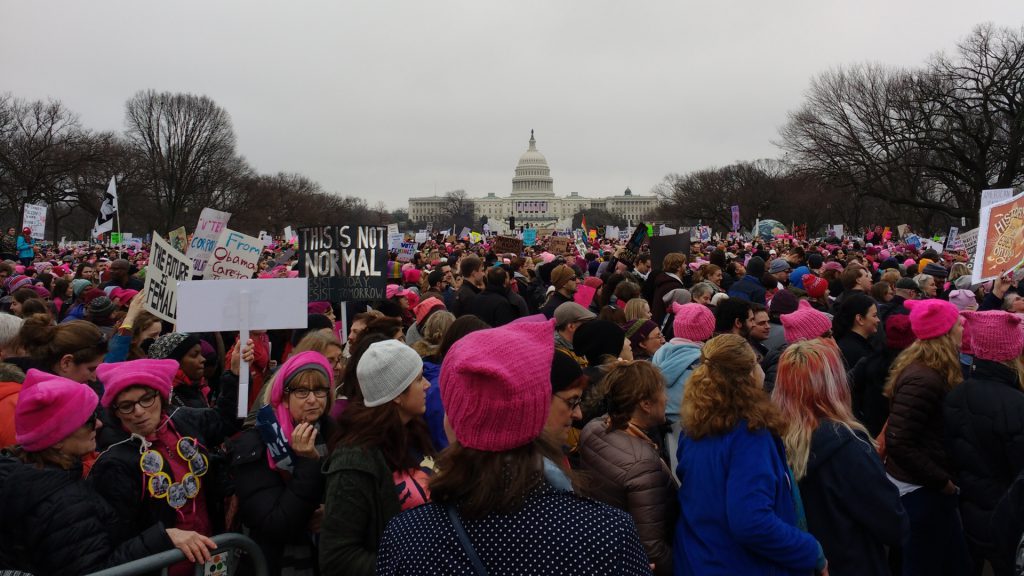
Published March 28, 2020
There are few words in American politics so hotly debated as “feminist,” a term that has come to mean all things to all people, used by some as an honorific and by others as a slur.
On the left, it’s a buzzword that signals a liberal stance on abortion or government-funded contraception. Sometimes, it’s a “get out of jail free” card. After several women accused him of sexual assault, producer Harvey Weinstein insisted that he couldn’t have harmed women, because he’s a feminist.
“I made more movies directed by women and about women than any filmmaker,” he offered in his defense, hoping his legacy of bankrolling Planned Parenthood would cover his multitude of sins.
On the right, feminism is far more divisive. Some on the far right believe that the ideology is defined solely by bitter, man-hating women. In response, these critics (mostly men) have become anti-woman, congregating in online forums to denigrate women and froth over an impoverished notion of masculinity.
Traditional conservatives, meanwhile, don’t think of the word “feminism” as toxic, but they correctly note that feminist thought has been overrun for decades by radical progressives who have demanded, and received, culturally harmful policy changes such as no-fault divorce and abortion on demand.
For author Sue Ellen Browder, feminism is a deeply personal term, one that once allied her with progressive radicals but today grounds her identity as a pro-life Catholic convert. In her new book Sex and the Catholic Feminist, Browder traces the history of what she facetiously calls “the F word,” focusing specifically on its ties to the abortion-rights movement. Her argument is simple: The term “feminism” can and should be reclaimed by conservatives, especially Catholics, who value authentic womanhood.
One of the book’s central themes is Browder’s effort to get to the heart of what motivates those who call themselves feminists. Having been a pro-abortion feminist who wrote for Cosmopolitan and other liberal women’s magazines for several decades, she has particular insight into this question, writing that she aims to “dig down to the roots of the old feminism to see where it went right and where it went wrong.”
Debates over women’s rights are still raging, according to Browder, because we know that we have yet to achieve “true respect for the dignity of a woman’s full personhood in both the public and private spheres of life.” While she recognizes that even radical feminists with whom she now disagrees are, deep down, striving for that goal, her book illustrates how they went wrong when they made “free love” their primary demand.
“What pro-life women oppose is not feminism itself, but the false joining of feminism with the sexual revolution,” she writes. “It’s not feminism (the call for women to be treated with equal dignity and respect) that’s contrary to Judeo-Christian values.”
Browder observes that, during his pontificate, John Paul II urged Catholics not to reject feminism but to embrace a “new feminism” and, in private audiences, called himself “the feminist pope.” His thinking on the subject was perhaps best expressed in his 1988 apostolic letter “On the Dignity and Vocation of Women,” in which he proclaimed the essential equality of men and women, as well as the distinct purpose for which women were created and the unique value they bring to the world.
In a handful of compact, highly readable chapters — the whole book is only about 130 pages — Browder shares the highlights and lowlights of feminism’s course through U.S. history, starting with the earliest feminists, many of whom were anti-abortion Christians fighting for women’s suffrage even under threat of imprisonment.
She scrutinizes the work of mid-century feminists such as Betty Friedan, Gloria Steinem, and Helen Gurley Brown, the last of whom Browder worked for at Cosmopolitan. Perhaps owing to her decades as their ally, Browder has a knack for drawing out the truth in their views where there was some, for instance in the value Friedan placed on motherhood.
But she’s unflinchingly honest, too, in exposing how feminists embraced the false idea that women could flourish only if they had unlimited sexual freedom, bolstered by the government. (Her chapter on the role of women’s magazines in fueling a sexually permissive culture is one of the book’s strongest sections.)
“The most destructive, divisive, media-perpetuated fantasy is the delusion that anything-goes sex with no commitment from the man somehow ‘liberates’ a woman,” she writes. And later, “The reduction of a woman’s full personhood to her sexual desirability and sexual desires is the real injustice we’re fighting.”
The second-wave feminist commitment to “liberated” sexuality is best exemplified by the demand for legal abortion, and here Browder is perhaps at her best, telling the tale of how abortion-rights proponents took over the feminist movement. In November 1967 at a meeting of the National Organization for Women, a bare majority of its members voted to include in the group’s bill of rights a demand to repeal all abortion laws. After the vote, one-third of the members resigned, feminists who were committed to women’s rights but who opposed abortion.
“Literally overnight, due to the vote of a mere fifty-seven people . . . ‘reproductive rights’ had become synonymous with women’s fight for equality in education and the workforce,” Browder concludes. This is one of the most crucial chapters, especially for those curious about how “feminism” came to mean, for both liberals and conservatives, an ideology that backs unlimited legal abortion as a hallmark of women’s autonomy.
As Browder illustrates, that wasn’t always the case, and, in her conclusion, she suggests that it needn’t be the case in the future, either. She avoids the pitfall of ending her book with an overwrought, impossibly vague “solution,” but she doesn’t leave readers without a way forward.
“Wars for women’s dignity are won not by prancing around Washington, D.C., with a pink pussyhat on your head but by going to the mat and laying down your life to suffer for your convictions,” she writes. Browder doesn’t call for martyrdom, but she offers a compelling role model: “When Mother Teresa was once asked what she thought about feminism, she replied she didn’t think about it: She was too busy taking care of the poor.”
Mother Teresa, Browder writes, “embodied everything the old feminists were secretly seeking: mission, purpose of life, joy, wholeness of personhood, even fame and power (which she completely ignored).” Her book concludes not with a road map to victory, but with the suggestion that the battle is already slowly being won, and will be helped along if we who value women for more than their sexuality show a greater willingness to reclaim feminism.
Alexandra DeSanctis is a staff writer for National Review and a visiting fellow at the Ethics and Public Policy Center.








